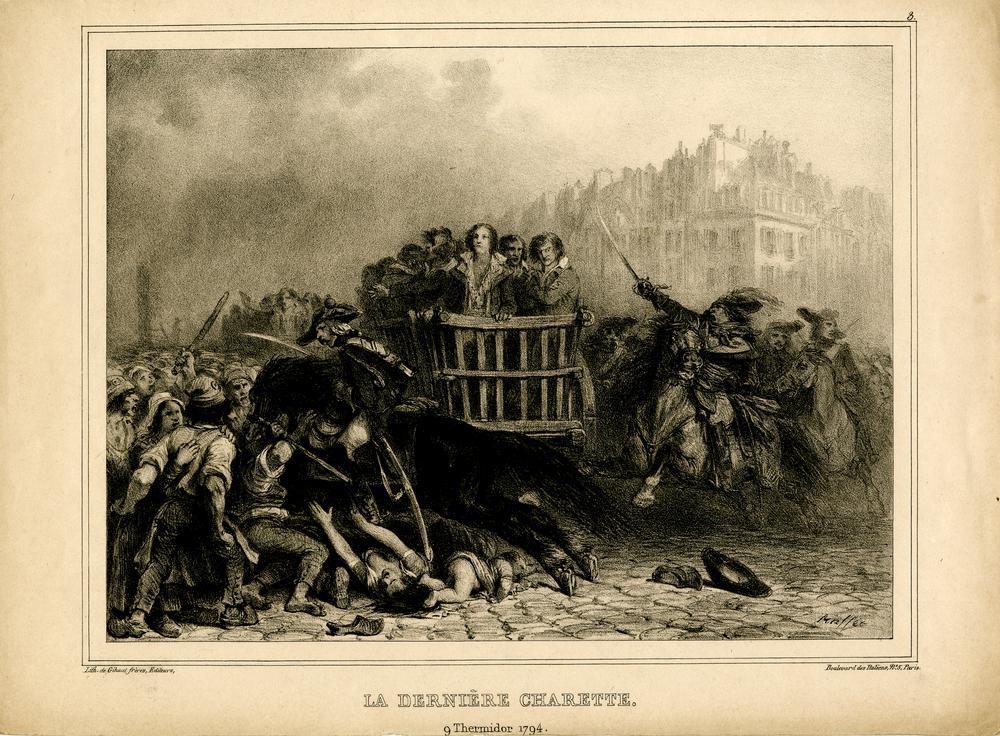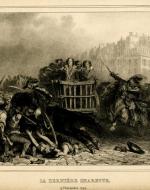Created by Gabriella White on Tue, 02/01/2022 - 14:30
Description:
The title of this image is La dernière charette, 9 Thermidor 1794. "[It] depicts a cart carrying the last victims of the Reign of Terror to the guillotine; with on the right, a soldier on horseback and his men rushing to help a soldier who is trying to repel the angry mob on the left. c.1835 Lithograph." (The British Museum) In English, La dernière charette, 9 Thermidor 1794 means "The Last Cart, 9 Thermidor 1794. The picture depicts the parliamentary revolt during the French Revolution, which began July 27, 1794. This parliamentary revolt was called the Thermidorian Reaction.
The Thermidorian Reaction led to the fall of Maximilien Robespierre and the end of the time period called the Reign of Terror. During the Reign of Terror, there were mass executions led by Maximilien Robespierre, and near the end of the Reign of Terror, the French began to feel overwhelmed by the number of executions. French citizens started to plot the assassination and eventual takedown of Robespierre--a leading member of the Committee of Public Safety and the primary advocate of the Terror.
"On 8 Thermidor (July 26) he gave a speech full of appeals and threats. The next day, the deputies in the National Convention shouted him down and decreed his arrest. He was arrested at the Hôtel de Ville, along with his brother Augustin, François Hanriot, Georges Couthon, and Louis de Saint-Just. The same guillotine that on 9 Thermidor executed 45 anti-Robespierrists executed, in the following three days, 104 Robespierrists, inaugurating a brief "White Terror" against Jacobins throughout France. The coup was primarily a reassertion of the rights of the National Convention against the Committee of Public Safety and of the nation against the Paris Commune. It was followed by the disarming of the committee, the emptying of the prisons, and the purging of Jacobin clubs. Social and political life became freer, more extravagant, and more personally corrupt. There was a splurge of fashion and a conspicuous consumption of bourgeois wealth, while the poor suffered from harsh economic conditions." (Britannica)
The image depicted this moment when the Reign of Terror ended and the Thermidorian Reaction began. It is an artist rendition of the last cart carrying the execution victims from the Reign of Terror. Romanticism persistently grew in response to the results of the social transformation the French Revolution and the Thermidorian Reaction caused. There are numerous indications of these impacts of the French Revolution in different pieces of Romantic art and literature, like the La dernière charette, 9 Thermidor print. By analyzing the effects of the French Revolution, one can conclude that Romanticism emerged as a response to the French Revolution. Instead of digging for the laws of nature and the logical side of humans, Romantics tried to have direct contact with nature. The French Revolution directly influenced Romantic artists and writers. The French Revolution, Reign of Terror, and the Thermidorian Reaction resulted in a fundamental change of society's function and ideals.
Many Romantics accepted and approved of the French Revolution, often writing works expressing this perspective. William Wordsworth, Samuel Taylor Coleridge, Lord Byron, and Percy Shelley all shared this perspective and point of view. They all believed that the French Revolution marked a highly transformative experience, as it changed the ways of society and helped the oppressed. The French Revolution altered the lives of all French citizens. It had even impacted many in the European continent, as it caused other countries to consider social reform, which greatly influenced literature and artwork. The print La dernière charette, 9 Thermidor represents this social reform and drastically transformational period of time.
Work Cited
The Editors of Encyclopaedia Britannica. “Paul-François-Jean-Nicolas, Vicomte De Barras.” Encyclopædia Britannica, Encyclopædia Britannica, Inc., https://www.britannica.com/biography/Paul-Francois-Jean-Nicolas-vicomte-....
Raffet, Auguste, and Gihaut Frères. “La Dernière Charette, 9 Thermidor 1794.” Britishmuseum.org, The British Museum, https://www.britishmuseum.org/collection/object/P_1863-0725-435. Accessed 10 Mar. 2022.
Copyright:
Associated Place(s)
Timeline of Events Associated with Reign of Terror
Part of Group:
Featured in Exhibit:
Artist:
- Auguste Raffet and Gihaut Freres


